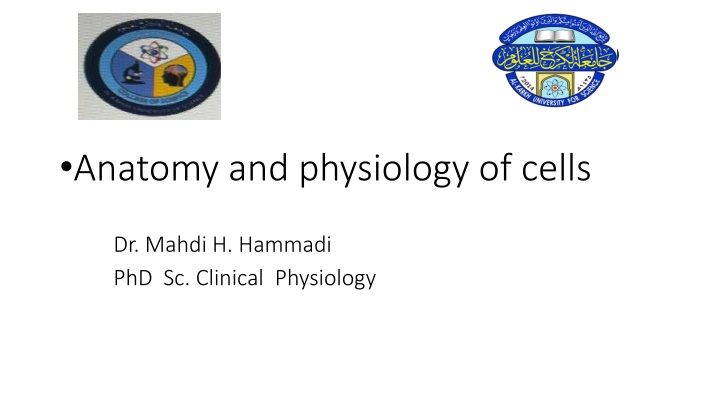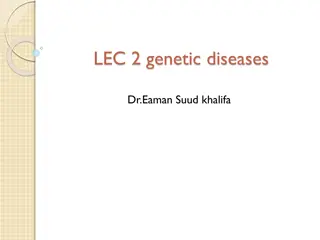
Anatomy and Physiology of cells
Explore the intricate details of cell anatomy and physiology through the teachings of Dr. Mahdi H. Hammadi, PhD in Clinical Physiology. Learn about the functions of the plasmic membrane, different types of extracellular fluids, the structure of the plasmic membrane, and the various modes of substance movement across cells. Delve into concepts like diffusion, osmosis, and active transport in this comprehensive study of cellular biology.
Download Presentation

Please find below an Image/Link to download the presentation.
The content on the website is provided AS IS for your information and personal use only. It may not be sold, licensed, or shared on other websites without obtaining consent from the author. If you encounter any issues during the download, it is possible that the publisher has removed the file from their server.
You are allowed to download the files provided on this website for personal or commercial use, subject to the condition that they are used lawfully. All files are the property of their respective owners.
The content on the website is provided AS IS for your information and personal use only. It may not be sold, licensed, or shared on other websites without obtaining consent from the author.
E N D
Presentation Transcript
Anatomy and physiology of cells Dr. Mahdi H. Hammadi PhD Sc. Clinical Physiology
What is the major function of the plasmic membrane? Binds the cell between the inside and the outside. Determines what substances leave and enter the cell. What are the 2 major fluids which travel within or out of the plasmic membrane? ECF - extracellular fluid ICF- intracellular fluid (cytosol)
What are 3 different types of ECF? 1. Interstitial Fluid 2. Plasma 3. Lymph Interstitial Fluid Also known as intracellular fluid or tissue fluid- located between cells of tissues Plasma A liquid component of blood Lymph Liquid located in lymphatic vessels.
The structure of the plasmic membrane is described as what? and what is its structure? Fluid-mosiac Model - a lipid bilayer containing proteins.
Integral proteins Strongly attached to the membrane Peripheral Proteins Loosely attached to the membrane Diffusion The way most substances move within the cell. The way substances move in/out of cell. spontaneous Concentration Gradient Different levels of concentration is the net movement of diffusion. What happens when the molecules are small enough to pass through the membrane and down the concentration gradient? The movement requires the cell to do no work.
Simple diffusion The diffusion of dissolved substances through the lipid bilayer of the membrane Facilitated Diffusion The diffusion of dissolved substances through an integral protein gate in the membrane Osmosis Water diffusion across the membrane What happens when the molecules are too large to pass through the plasmic membrane by diffusion? The cells requires work thus beginning of Active Transport or Vesicular Transport.
What are the 2 parts of Vesicular transport? Endocytosis and Exocytosis Endocytosis Large molecules enter the cell with the plasmic membrane producing vessels. Exocytosis Large molecules exiting the cell. First they are formed in vesicles which are formed within the cell Cytoplasm The part of the cell inside the plasmic membrane , and outside the nucleus
Cytosol (ICF) (cytoplasm) Contains water, ions, and enzymes. Ribosomes (cytoplasm) Particles made of proteins and RNA where protein synthesis occurs. They may float freely or be attached to internal membranes. Cytoskeleton (cytoplasm) A network of protein fibers that run throughout the cytosol and supports and moves the cellular structures. Organelles (cytoplasm) Membranous structures with distinctive shapes and function Endoplasmic Reticulum (organelle) A network of membrane enclosed passage ways that run throughout the cytosol
Rough Endoplasmic Reticulum Contains Ribosomes Smooth Endoplasmic Reticulum Contains no ribosomes. Stores Ca ions and makes or breaks fat. Golgi Apparatus (Organelle) A series of flatten membrane-bound sacs stacked upon each other. What is the name job the the Golgi apparatus? It receives and sorts products of the rough ER and packages them into vesicles for proper delivery within or out of cell. Also the production of lysosomes.
Lysosomes (organelle) Membrane-bound sacs containing digestive enzymes to be secreted or for intracellular digestion Peroxisomes (organelle) Membrane-enclosed sacs containing enzymes to destroy various harmful molecules. Mitochondria (organelle) Provide the most energy used by the cell Nucleus Contains genetic information or DNA
Centrioles (organelle) A pair of cylindrical organelles located close to the nucleus. Important for cell division. What is the main function of pores in the nucleus? Allow for substances in/out of the cell.



![Lec [2] Health promotion](/thumb/274962/lec-2-health-promotion-powerpoint-ppt-presentation.jpg)